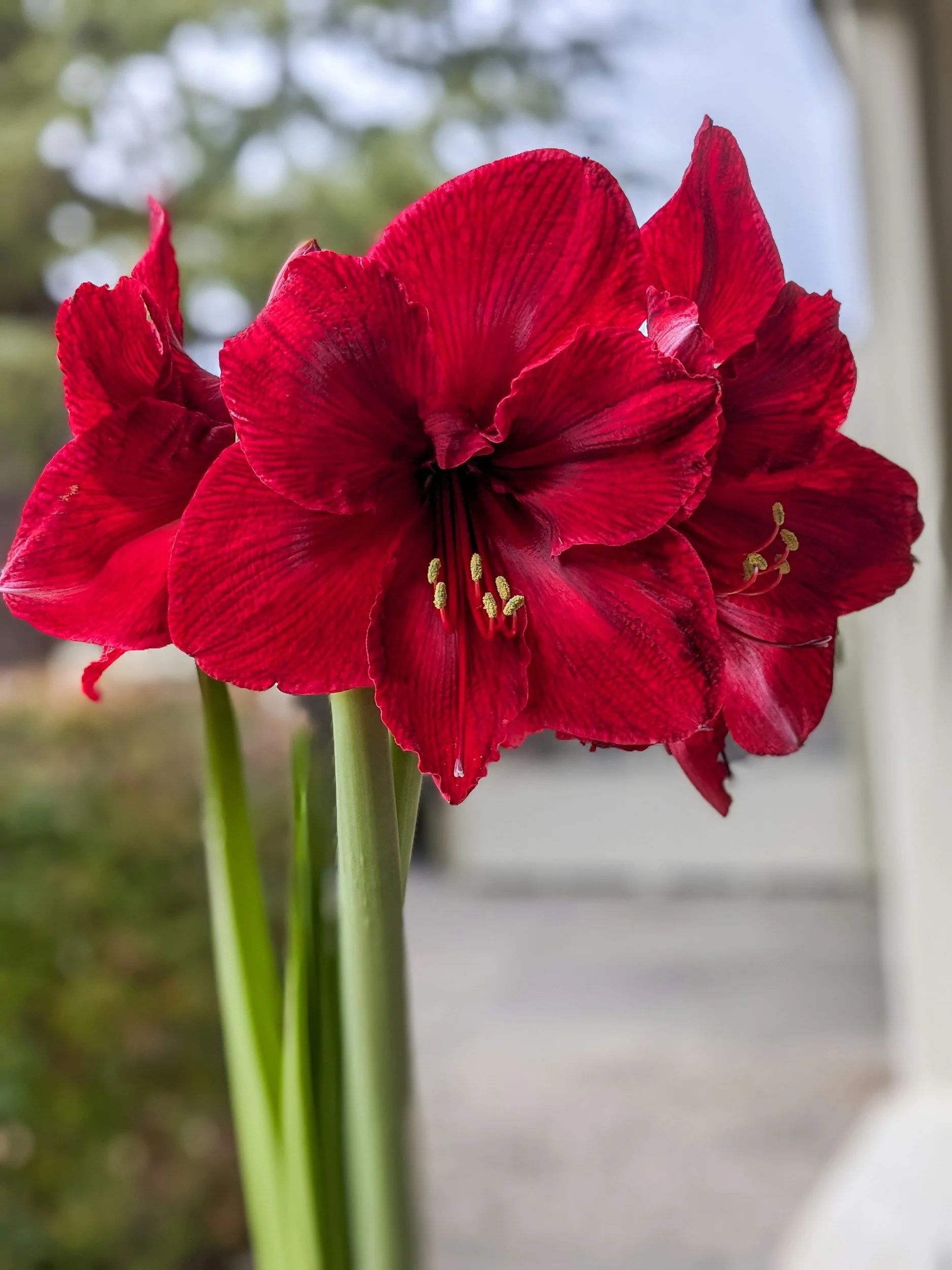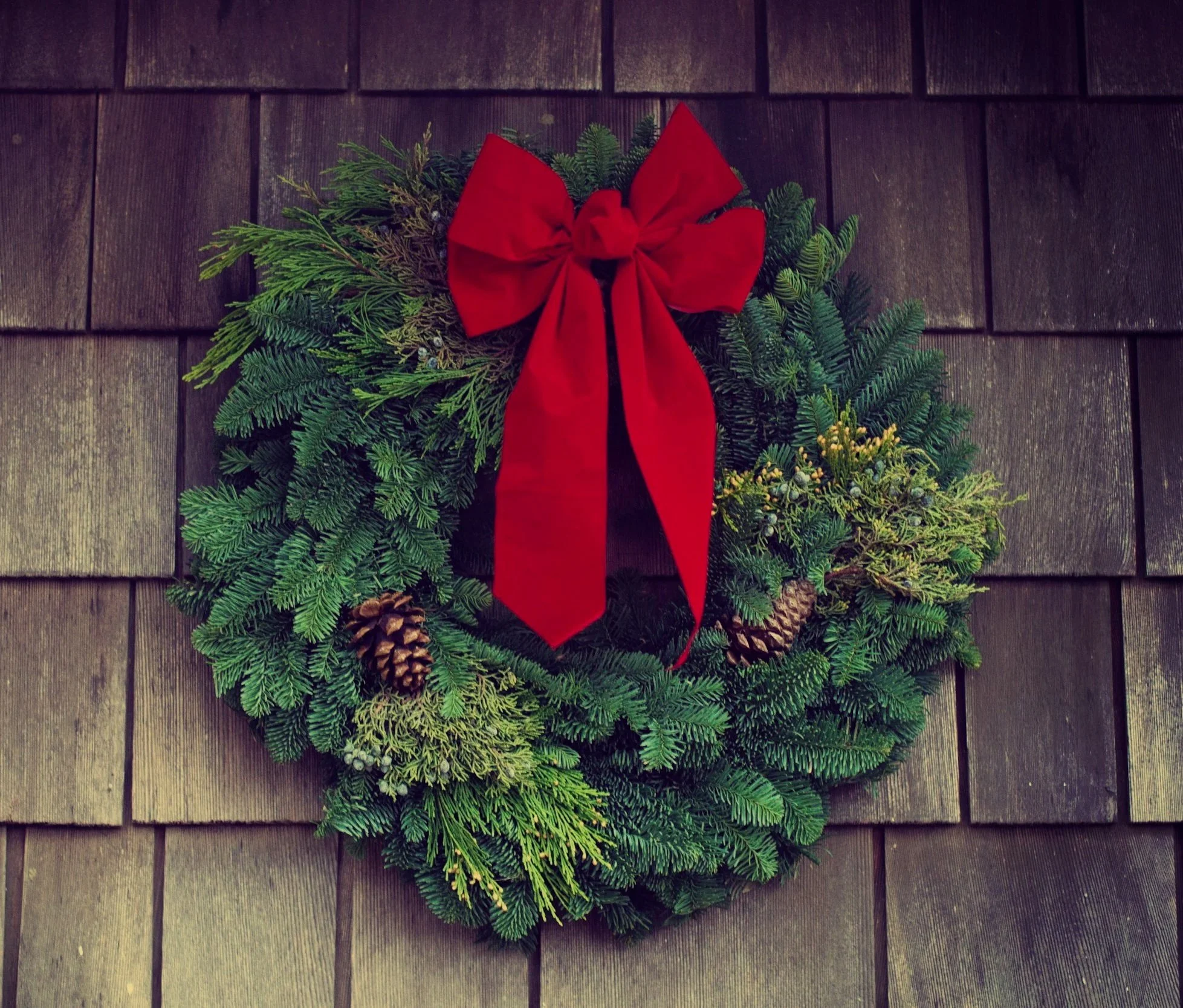Paperwhite Care
Place in bright, indirect light
Keep soil lightly moist (not soggy)
Cooler temps help blooms last longer
Typically blooms in 2–4 weeks
Turn pot every few days for straight growth
Discard after blooming (usually does not rebloom)
Amaryllis Care
Place in bright light, some direct sun is fine
Water when the top inch of soil is dry
Stake tall stems if needed
Typically blooms in 6–8 weeks
After blooming: keep leaves to encourage rebloom
Evergreen Wreath Care
Keep in a cool, shaded area (out of direct sun & wind)
Lightly mist or spritz every few days to keep greens fresh
Best displayed outdoors or in an unheated entryway
Avoid placing near heat sources (fireplace, vents, radiators)
If used indoors, expect a shorter lifespan
Natural shedding is normal as it dries
Tip: The cooler and shadier the spot, the longer your wreath will last.
Dried Flower Wreath Care
Place out of direct sunlight to retain color
Dried flower wreaths should only be displayed indoors, they are fragile and wind will break the stems and blooms
To dust, gently blow on the wreath
A quick guide to caring for your local, fresh-cut flowers
Prepare your vase: Clean your vase with warm, soapy water to remove any bacteria that could cause the flowers to deteriorate faster. Rinse it thoroughly before filling it with fresh water.
Trim the stems: Use sharp scissors or pruning shears to trim about an inch off the bottom of each stem at a 45-degree angle. This creates a fresh surface area for better water absorption.
Remove excess foliage: Strip off any leaves that would be submerged in the water, as they can promote bacterial growth and cause the water to become cloudy.
Use fresh water: Fill the vase with room temperature water. Avoid hot or cold water, as extreme temperatures can shock the flowers.
Add flower food: If your flowers came with a packet of flower food, mix it into the water according to the instructions on the packet. Flower food contains nutrients and antibacterial agents that can help prolong the life of your flowers.
Place in a sheltered location: Keep your flowers in a cool, draft-free area away from direct sunlight, heating vents, or appliances that produce heat. Excessive heat can cause your flowers to wilt prematurely.
Change the water: Every two to three days, change the water in the vase and trim the stems again. This helps to prevent bacterial growth and keeps the water fresh, prolonging the life of your flowers.
Monitor water level: Check the water level in the vase daily and top it up as needed to ensure that the stems remain submerged. Flowers absorb a lot of water, especially in the first few days after being cut.
Remove wilted flowers: As flowers start to fade or wilt, remove them from the arrangement. This not only improves the appearance of your bouquet but also prevents ethylene gas produced by wilting flowers from hastening the ageing of the remaining blooms.
Cut Flowers and Their Typical Vase Life
Cosmos:
Cosmos have a vase life of 5 or so days. We recommend removing spent flowers from your arrangement ASAP, as they can start to drop petals quickly.
Daffodils:
Daffodils typically have a vase life of 5 to 7 days. Daffodils release a toxic sap from their stems when they’re cut. This sap can cause other flowers to decay prematurely, so we recommend keeping them isolated (other daffodils will be okay) or separating them for 3-4 hours before mixing them with other flowers in your arrangement. If you receive daffodils from us, they’ve been conditioned, but you’d need to condition them every time you trim the stems. Yes, it’s a pain, but it's worth it to enjoy your flowers a bit longer.
Dahlias:
Dahlias typically have a vase life of 4 to 7 days. Dinnerplate (large, ruffled) varieties have a shorter vase life than the smaller ball or pom-pom varieties.
Snapdragons:
Snapdragons have a relatively long vase life of 7 to 10 days.
Sunflowers:
Sunflowers typically last 5 to 7 days in a vase. Sunflowers are considered a “dirty” flowers, meaning they can make their water murky. They benefit from a full water change vs. a daily topping-up.
Tulips:
With a vase life of about 3 to 7 days, these spring beauties can last a while with proper care. The key to longer-lasting tulips is keeping them trimmed. Single-flowered tulips tend to last longer in the vase than double-flowered varieties.
Zinnias:
Zinnias typically last 4 to 7 days in a vase. Zinnias are another “dirty” flower. Make sure to use lukewarm water with zinnias as they’re very cold-sensitive.



